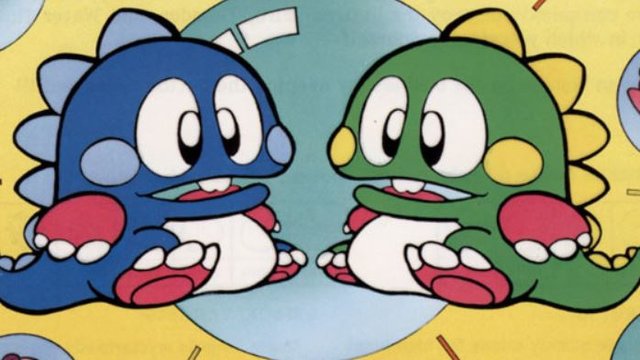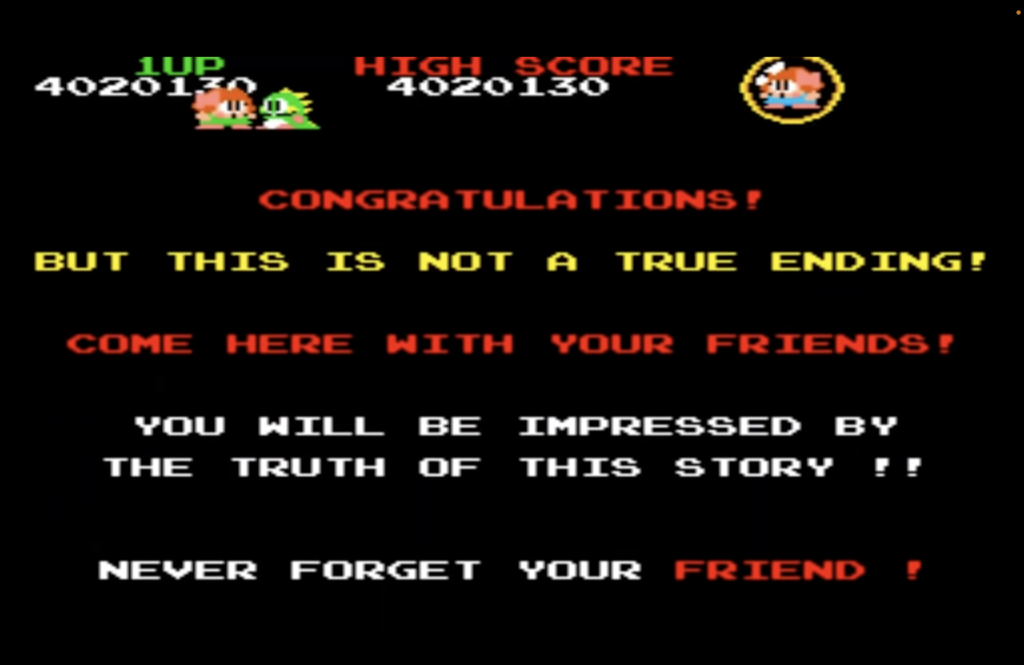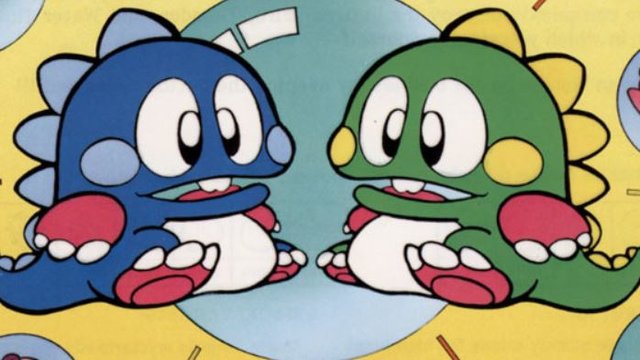In Bubble Bobble, the evil Baron Von Blubba has turned brothers Bubby and Bobby into two cute and lovable Bubble Dragons, Bub and Bob, and kidnapped the brothers’ girlfriends, Betty and Patty. To rescue their girlfriends, Bub and Bob must make their way through 100 levels of increasing difficulty in the Cave of Monsters. Faced with a number of enemies, the dragons must shoot and trap them in bubbles which float the monsters to the top of the screen. If the dragons collide with these bubbles before the monsters break free, the enemies are defeated. If a dragon collides with a free monster, however, the dragon loses a life.

Released in 1986, Bubble Bobble is a platform arcade game developed by Fukio “MTJ” Mitsuji at Taito, a Japanese company that was an early industry leader in the video games market. With bright colors, jumping and shooting mechanics, and combat with 2D enemies, Bubble Bobble resembled many of the other platform arcade games of its time. The difference came from the creative direction of MTJ. In an interview, when asked about his inspiration for the game’s characters, he described how he set out to make a thrilling and intuitive game that would solve the male-dominated demographic he noticed in Japanese arcades. He focused on the bubble core mechanic to appeal to female players and he centered the game around its cooperative mode to attract young couples to the arcade. While his artistic vision for the game might be criticized by modern standards for enforcing gender stereotypes and expectations, his choices as a game developer with Bubble Bobble represent an important historical step for broadening the target demographic of arcade games and a concrete example of how art design and cooperative game mechanics can affect the social and cultural impact of a game.

When asked by an interviewer how he came up with the cute characters for Bubble Bobble, MTJ explained that he noticed how “women were rarely seen in Japanese arcades” (2). Brainstorming ways to solve this issue, he decided to attract couples to the arcades and that’s why he “designed cute characters and included cooperative play in Bubble Bobble” (2). In a different interview, when asked about the inspiration behind the bubble core mechanic, MTJ described how he thought, “well, what kind of things do young girls like to draw and sketch?” (1). While critics might point out that young girls can be interested in video games beyond cute art styles and lovable character design, MTJ was still successful in turning his personal vision for an approachable game for young couples into an implemented product that aligned with these design goals. How exactly did he implement these considerations?
Bubble Bobble presents a cohesive audiovisual experience that emphasizes cuteness and encouragement. The dragons are short and stubby with large eyes and a wagging tail, design elements that contribute to a sense of “cuteness” for the player. Instead of leaving behind corpses, the monsters turn into fruits when they are “defeated” by the player. The background music sounds like a child-like march with a bright tone and joyful melody. Similar to the 1980 classic Pac-man which featured round and colorful characters to appeal to young and mixed- gender audiences, Bubble Bobble employs art style to target certain player demographics.

Going a step further than Pac-man, however, MTJ implemented special game mechanics and variable endings to focus on the cooperative mode for Bubble Bobble and attract young couples to the arcades. When Level 100 is completed in single-player mode, Betty is free while Patty remains captive, with the game presenting the player with a message stating, “…THIS IS NOT A TRUE ENDING! COME HERE WITH YOUR FRIENDS!” (3). If Level 100 is completed in two-player mode, however, both Betty and Patty are freed, and the players are given the opportunity to beat the game on a special Super Mode. If the players can endure the faster speed and higher difficulty of the Super Mode, they are rewarded with a special narrative centering around the brothers’ parents. As one of the first games to utilize multiple endings, Bubble Bobble implements this mechanic to explicitly encourage cooperative play.
While the combat mechanics and level progression structure of Bubble Bobble weren’t particularly special for its time, MTJ utilized cute art styles and cooperative game mechanics to create a game uniquely positioned to attract young couples to the arcades. Demonstrating the capabilities of the game designer, he set out with a vision for his game and a goal in mind for his target demographic, and was able to execute on his game through these implementations. Taking MTJ’s intentions as a game developer along with its commercial success, Bubble Bobble claims an important place in the lineage of games with diverse demographics and marks an important step in the development of meaning-producing game mechanics such as the cooperative mode.
Bubble Bobble Emulator: https://www.retrogames.cz/play_216-NES.php?language=EN
Citations
- Fukio Mitsuji. “1988 Developer Interview.” BEEP!, 1988. https://shmuplations.com/bubblebobble/
- Hasegawa, Tadasu, and Fukio Mitsuji. “Interview with Fukio ‘MTJ’ Mitsuji, from Taito Legends.” Taito Legends. https://www.youtube.com/watch?v=DbLI9_5WDkc
- MamePlayer. “Bubble Bobble Round 99-100 Happy and Real End 1986 Taito Mame Retro Arcade Games.” YouTube, YouTube, 25 Dec. 2014, https://www.youtube.com/watch?v=9TgKuJxaWQU.


This is an interesting post about a game I’ve never heard of before! I find your discussion of Bubble Bobble reinforcing gender stereotypes interesting, because that was my initial thought upon hearing the connection between the somewhat silly character names/designs and your argument that the game was intended for female players. However, you bring up a really important point that this argument shouldn’t overrule the fact that the game was historically significant for even making an effort to cater towards female videogame players. I’m curious whether Bubble Bobble (and other games like it) had any immediate impact on the Japanese arcade scene – it would be cool to look at a demographic report to see whether more women starting visiting arcades either alone or as a couple, although I doubt such a comprehensive report actually exists.
I also hadn’t heard of the game before haha. I wrote about Bubble Bobble because I found the game designer’s interviews to be very compelling. He very explicitly outlined his intentions for targeting female players, so that’s what I focused on in my blog post. It was a popular arcade game both in Japan and abroad (perhaps I should’ve included those statistics in the original post), but unfortunately I couldn’t find any real demographics numbers.
I really appreciate your research and analysis. The fact that game designers like MTJ attempted to broaden the game audience to include females also seems to signify the recognition of a vast “feminine” market in Japan. I also find it interesting that MTJ stuck to the chivalric narrative of male characters going on a journey to rescue female characters while trying to target young couples. Wouldn’t the couple feel more identified with the narrative if the game is about a couple or two friends trying to escape a dungeon together? This touches on another question: when and how did playable female characters appear in games?